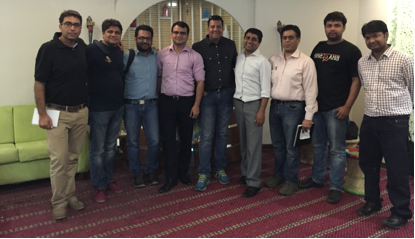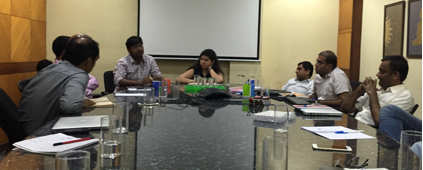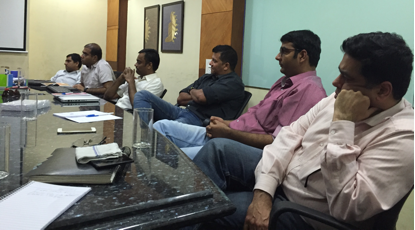An iSPIRT Playbook round table
 So India won against Pakistan in the world cup match….again. I’m sure none of you would have missed it for the world. As you watched every ball with your heart in the mouth, you would have noticed some players performed while others faltered. But in the midst of it, one man stood tall. Virat Kohli, once again proved that he can perform in the toughest of conditions against the best of teams. So what makes Virat Kohli click where other great batsmen stumble ?
So India won against Pakistan in the world cup match….again. I’m sure none of you would have missed it for the world. As you watched every ball with your heart in the mouth, you would have noticed some players performed while others faltered. But in the midst of it, one man stood tall. Virat Kohli, once again proved that he can perform in the toughest of conditions against the best of teams. So what makes Virat Kohli click where other great batsmen stumble ?
Similarly, you see some startups stagnate while others scale consistently. Is there any method to this madness ?
Successful startups who scale are ones who continuously try to improvise, holding on to their strenghts while improving their weaknesses. They build a process driven organisation fixing bottlenecks as they grow. Virat Kohli also worked hard to improve as a batsman, mastering his weakness against the short ball, and learning new strokes even though he was successful without them. Every player starts his international journey with a few apparent flaws. While some work diligently to remove them, others work around them. Then there are those who become victims of their own flaws before they can eliminate them. Similarly, startups who take early success for granted, fall and ultimately perish.
So how do I successfully scale my startup ? When do I know that I’m ready to scale ? Which countries and verticals do I expand?
Should I grow organically or inorganically ? Is enterprise selling important ? How do I build a successful sales team with predictable pipeline ? How does channel sales work? All this many such pertinent questions must be bothering you when think of scaling your startup !
This is why a bunch of successful startup founders met to discuss and understand the process to scale. The 63rd iSPIRT round table on “Scaling Revenues” was led by Aneesh Reddy, CEO Capillary technologies on 13th March, 2106 at Knowlarity, Cybercity office. Ambarish Gupta CEO Knowlarity was the host and also a participant. I was fortunate to participate as an iSPIRT volunteer and met some of the great startup founders there.

The list of attendees are as mentioned below:
- Ajay Chauhan @salezshark.com
- Anand Krushnan @exclusife.com
- Aniruddh Jain @salespatron.com,
- Bishal Lachhiramka @drishti-soft.com,
- Dinesh Gupta @busy.in,
- Sachin Bhatia @drishti-soft.com,
- Sakshi @posist.com,
- Vishal Bansal @zenatix.com,
- Tushar Bhatia @empxtrack.com,
- Kushal @fareye.in,
- Subrat Kar @vidooly.com,
- Samit Arora @salespanda.com,
- Rajat Harlalka @iSPIRT volunteer
- Ketan @Mettl
RT leader Aneesh Reddy@capillerytech.com
Host & Ambarish Gupta @knowlarity.com
Lets look at some of the key points discussed in the round table on “Scaling Revenues”
One of the first fundamentals you want to know is that when do you know you are ready to scale ?
Every startup goes through establishing its niche or the product market fit, wherein you get your first 100 paying customers who are not your family and friends. These are customers who know that you are addressing their painpoint and yours is not just a good to have solution. It is very important to ensure you get it right else all your scaling efforts will be futile. Like ‘Steven Covey ‘ in his book 7 habits of highly effective people says “ If the ladder is not leaning against the right wall, every step we take just gets us to the wrong place – faster.”
Now that you are ready to run, faster than the fastest, which market do you expand. India being an easy access, most SaaS founders start with India unless they have a cofounder in US or some associates. So is India the right market to start with ? There are multiple schools of thoughts here. Like Ambarish from knowlarity mentined that they built the company with clients from India and scaled it to a level where their core sales team and processes were established. The initial days of scaling are tough so if you have good acess to clients it can be really useful. Knowlarity then expanded to similar geo’s like Phillipines, Singapore and Malaysia which are english speaking and have similar business culture like India and other ASEAN countries.
Others like Aneesh from Capillary, Tushar Bhatia from Empxtrack and Sachin Bhatia from InsideSalesBox, prefered pitching to US clients first as they see a higher demand and buying maturity in clients there. One of the common observation the group had was that in US you will see only genuine prospects engaging with you so while the pipeline might take time to build, the conversions are better if the value proposition is right. Indian and ASEAN clients are more open to discussion with longer cycle times and lower conversions. Beyond the ASEAN and US, Sachin Bhatia also shared his experience of selling to African clients. He having travelled to 34 countries is quite qualified to write a book on this subject…May be “Selling SaaS to Nomads” or something around it J
Another interesting aspect of selling to US clients came up from Abhinav from Innovacer (watch out, innovacer might be the next mu-sigma in the making ! ) who have mastered the art of leveraging US based events to build a pipeline. Abhinav shared how they build an US events calendar and take up nominal booths there to meet larger base of prospects there. Its well planned and meetings are lined up with delegates much in advance. Event particpation helps in spending time with prospects away from office workload wherein the clients are also in a frame of mind to evaluate options. But you need to ensure, enough homework is done and meetings are planned in advance. Sachin Bhatia also shared similar experiences and vouched for importance of event participation to reach US clients.
The next question was the importance of enterprise sales and larger deals. How do you increase your average deal size and sell higher to enterprise clients?
Lets admit it. Everyone likes enterprise clients. They have the apetite to invest big and also act as a testimony for your product to scale. Aneesh shared his experience around selling to enterprise customers. The deal ticket size can be increased in multiple ways . First – you scale horizontally ie you can upsell and cross-sell. Which means you need to build multiple product modules which can be sold to same clients over the years increasing the account revenue. Next you can scale vertically by intially selling to a pilot base and then expanding into the account. For eg you can sell it to 10 retail outlets and then expand to 200 later or sell to one office and then expand to other locations. Enterprise selling needs you to have the scale or options built into your value proposition. Build new complimentary offerings every year.
 Channel Management was the another crucial aspect discussed. Dinesh Gupta of Busy software(www.busy.in) led the discussion. Busy competes with Tally as a market leader. They built and scaled a product in a market where tally is a houseold name amongst Chartered accountants their key evangelists. Couple of important points amonst many pointed by Dinesh are here. Firstly, Identify partners for whom your product and revenue are substantial part of their business. In other workds they need to have their skin in the game. Otherwise you’ll end up having a lot of channel partners but no sales. The other important aspect of channel sales is to educate the partners. Education helps twofold. It creates a buy-in amonst the partners who can then sell better. Plus it helps them put the value proposition better in front of their customers. The group also discussed channel margins and how much to pay. While it was a long discussion, the crux of it was that you should pay partners well , may be more in initial days to get a foothold in new markets. It has to be enough of a motivation for them to sell. Subrat Krar from Vidooly also shared his experience on how they are leveraging marketing agencies as channel partners to expand their video analytics software.
Channel Management was the another crucial aspect discussed. Dinesh Gupta of Busy software(www.busy.in) led the discussion. Busy competes with Tally as a market leader. They built and scaled a product in a market where tally is a houseold name amongst Chartered accountants their key evangelists. Couple of important points amonst many pointed by Dinesh are here. Firstly, Identify partners for whom your product and revenue are substantial part of their business. In other workds they need to have their skin in the game. Otherwise you’ll end up having a lot of channel partners but no sales. The other important aspect of channel sales is to educate the partners. Education helps twofold. It creates a buy-in amonst the partners who can then sell better. Plus it helps them put the value proposition better in front of their customers. The group also discussed channel margins and how much to pay. While it was a long discussion, the crux of it was that you should pay partners well , may be more in initial days to get a foothold in new markets. It has to be enough of a motivation for them to sell. Subrat Krar from Vidooly also shared his experience on how they are leveraging marketing agencies as channel partners to expand their video analytics software.
The team also spent some time discussion the sales team structure, hiring VP of Sales and how to build a scalable predicable pipeline. From what I gathered, it seemed that setting up an inside sales team is no brainer. It’s a must have. How to ensure it delivers is a larger discussion for which you might want to talk to an expert amounst people above who have scaled or to Sachin bhatia who has a product in the same space. But to build a sustainable pipelines, you need to also put the right metrics in place for the sales team. Eg the inside sales team should be measured on fixed demos, the sales team on closures. Few participants discussed sales quotas for sellers ranging from 1:4 to 1:10 of the CTC. Tushar from Empxtrax and Ketan from Mettl also shared their insights and metrics on hiring costs and metrics.
Depending on the product and brand pull it may vary. Ultimately it should not be so much of stretch for the seller that he does not even feel like trying nor it should be so easy for him that he does not get the aldrelin rush while closing a deal. You need to find your sweet balance.
 Premium/Free Trial vs no pricing mentioned on website was another aspect discussed. Different people have different models but largely the group agreed that most are moving away from freemium and those targeting enterprise do not prefer to display the price on the site at all as it varies by scale and need of clients.
Premium/Free Trial vs no pricing mentioned on website was another aspect discussed. Different people have different models but largely the group agreed that most are moving away from freemium and those targeting enterprise do not prefer to display the price on the site at all as it varies by scale and need of clients.
Aneesh also shared his views and experience on attaining inorganic growth. Capillery having recently acquired MartJack, an esablished online ecommerce software company was best placed to answer it. Aneesh mentioned that any new startup takes 1.5 to 2 years to establish their product market fit and then to scale to a level where they are ready for enterprise sales. If you want to continuously increase your client revenue share and grow the market, inorganic acquisitions help you in cutting the time to the market. This then helps you focus on other aspects of scale.
Overall another wonderful round table by iSPIRT. Need to thank our man Avinash for arranging the round table. He is like Tendulkar, silently but strongly delivers what his fans wantJ. Special thanks to Ambarish for hosting us at Knowlarity and for his insights into scaling startups. Finally, many thanks to Aneesh and Anant from Capillery for leading such an interative round table and sharing deep insights from their business.
Okay, enough of insights and tips. Lets get down to basics. What do you think is India’s chance to win this T20 world cup ? Fine, we lost to New Zealand in Nagpur but the same thing happened in 2011 (when India lost to South Africa in Nagpur) and we went on to the win the World Cup. We are now on a high after beating Pakistan. As Pakistani team would say “Goli se daar nahi lagta sahab, Kohli se lagta hain (Pakistan don’t fear bullets, they fear Kohli)” (courtesy Sehwag commentary)
But you guys have nothing to fear. Take the leap of faith as you step forward to take your startups to new heights.
Take your wings and set on to fly
You might stumble but that’s only when you try
Don’t just give up if you face a few bump
Coz harder the conflict the more glorious is the triump
Happy Scaling guys ! And India will surely Win the T20 World Cup !

